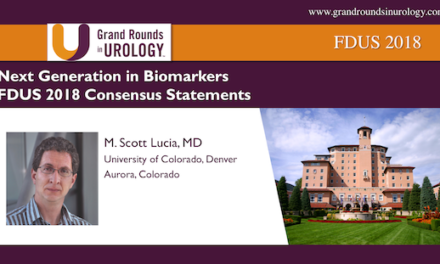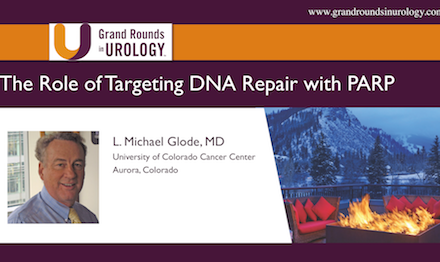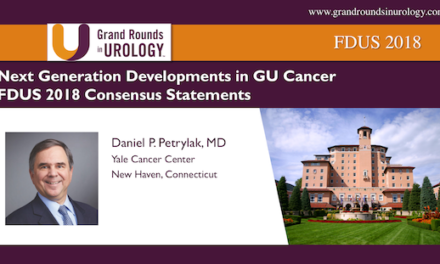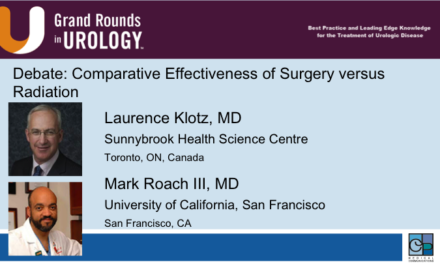Novel Hormonal Therapies for Prostate Cancer
How to cite: Bryce, Alan H. “Novel Hormonal Therapies for Prostate Cancer” November 12, 2017. Accessed Nov 2024. https://dev.grandroundsinurology.com/Novel-Hormonal-Therapies-for-Prostate-Cancer/
Summary:
Dr. Alan H. Bryce, MD, discusses the newest advances and research in prostate cancer treatments that target androgen receptors, such as BET inhibitors and CYP17 inhibitors, as opposed to chemotherapeutic and radiopharmaceutical approaches.
Novel Hormonal Therapies for Prostate Cancer
Transcript:
All right, so we’ll start out with our audience response questions. Hopefully we get this from yesterday. What portion of the androgen receptor is lost in the AR-V7 splice variant; the ligand binding domain, the zinc finger, the DNA binding domain, or the microtubule binding domain? It just puts you in the mood, the music. You know? All right. All right, very good, all right, so I think I did a good job yesterday I hope.
All right. What enzyme is responsible for converting glucocorticoids into androgens; CYP11 beta hydroxylase, CYP17 alpha hydroxylase, CYP17,20 lyase, or cholesterol side chain cleavage enzyme? Boy, that one just ruined the mood. You took us from one extreme to the other. You know? All right. All right, very good. Let’s see what we’ve, well we’ll dig into this a bit further. The difference between the enzyme is really important when we start talking about what do we try to target with these next generation anti-androgen drugs, androgen pathway inhibitors.
So, this is a very traditional, simplified androgen receptor pathway. And of course, everyone here knows this like the back of your hand. Right? So, the initial stimulus for androgen synthesis is LH/RH being secreted by the hypothalamus down to the anterior pituitary. This is of course where the LH/RH agonists and antagonists would have their activity. And then you have ACTH and LH which are produced, ultimately stimulating testosterone production, which is going to be 85 to 90% in the testes, 15/10% in the adrenals.
And then you have androgen production, which of course circulates in endocrine fashion, binds to the androgen receptor, which is a, as we said yesterday, a cytoplasmic protein. It’s stabilized in the cytoplasm, bound to a number of other proteins, including HSP or heat shock protein, which we’re not going to talk about today, but this is relevant because HSP is targetable by some therapeutics that are currently in trials. When the ligand binds to the androgen receptor the AR then migrates into the nucleus where it binds to the androgen response elements, stimulating transcription of genes and then cell growth and proliferation.
As I was saying yesterday, there is nearly 1,000 genes which can be regulated by androgen response elements. There’s 20,500 genes or so in the human genome. You’re talking about 5% of the genome under direct control of the androgen receptor. This is why, unlike in most malignancies, a single pathway is enough to stimulate carcinogenesis. This one pathway, this one receptor controls enough mechanisms, enough genes to stimulate the growth of a cancer cell.
All right, so if we conceptualize how prostate cancer progresses clinically. This is the model I would use to think about what’s going on with my patient, and this truly is how I’m thinking about my patient when they’re sitting in front of me. I’m trying to think about what’s the best treatment approach.
So, in the beginning, we start out with the endocrine-dependent disease. Right? This is your standard patient, castration sensitive, the malignancy relies on the endocrine production of androgens for growth, and of course, we treat that with androgen deprivation. And that works. Right? It works very well in most patients. It works phenomenally well in a handful of patients. But Dr. Crawford is absolutely right, we all have those patients who are 10, 15, 20 years out on ADT alone, but in most patients that’s not enough.
So, after we apply the selective pressure of castration we then get a variety of mechanisms leading to resistance, whether that’s AR amplification, in some cases intratumoral androgen production. So, these are those patients in whom circulating serum androgen levels are indeed castrate. But if you do a tumor biopsy and measure the intratumoral androgen level it is extremely high because the tumors learn to make its own testosterone supply.
AR mutations can make the AR more sensitive to lower levels of testosterone by binding testosterone more avidly. So, when that happens we then end up with what I would call intracrine-dependent or you could call it castration-resistant prostate cancer, and this is that prostate cancer that can live on the starvation diet of low testosterone if it’s going through an AR amplification pathway, or it’s instead learned to synthesize its testosterone supply. And so this is where we start talking about next generation, second, third, fourth generation androgen pathway inhibitors. And I say androgen pathway inhibitors to be inclusive of antiandrogens, so, the enzalutamide, flutamide, nilutamide, that whole family of drugs. But also to include the androgen synthesis inhibitors, so abiraterone, ketoconazole in the family of drugs that are being developed to follow on there.
But of course, that’s not the end-all because in most cases people will become resistant to this intervention within 18 months or so. So, then that can happen by a variety of mechanisms, and we’ve talked about the AR-V7 splice variant, so the loss of the ligand binding domain on the androgen receptor as one mechanism of that resistance. Other AR mutations, which can either make the AR constitutively active or resistant to the drugs we’re trying to use, or perhaps susceptible to stimulation by other non, and I should say non-androgen, not non-AR, but non-androgen oncogenes. So, in some evolved or resistant prostate cancers glucocorticoids become stimulatory. Estrogen can become stimulatory. Other non-androgen ligands can stimulate the AR through AR mutational processes.
So, when that happens we develop what I would term as this ligand independent but still AR-dependent prostate cancer. What we mean there is the androgen receptor pathway is still driving the growth of the cancer cell. The AR is still binding to the androgen response elements to promote carcinogenesis, but the ligand no longer matters. Right? So, anything we do then to manipulate testosterone or dihydrotestosterone, or antiandrogen no longer has an impact on the cancer cell, and yet the androgen receptor is still fundamental. So, are there ways to manipulate the androgen receptor in a way that has no dependence at all on testosterone?
And so, you know, the easy answer here is well chemotherapy. Certainly, right? It doesn’t depend on testosterone, radium-223, another way a ligand independent treatment mechanism. But if you have this disease process then things like enzalutamide, or abiraterone, or Lupron or Degarelix just aren’t going to have an impact.
So, we treat the patients here but things get worse, and we get develop, and we’ve all seen this, these high-grade neuroendocrine cancers or these small cell variants. Ultimately, even prostate cancer can evolve into AR-independent cell growth. You know, at this point what we’re talking about is a generalized carcinoma. That’s really evolved down what I would describe as the common final pathway for a large variety of malignancies. The prostate cancer at this state is independent of the androgen receptor in total, and at this point is no different than a lung cancer or a colon cancer, or any other malignancy that’s not dependent on hormonal stimulation. And you start looking at the mutation profiles of these cancers and then this is essentially similar to all of those other malignancies I’m talking about, highly mutated, lots of copy number variations. Yes, the AR amplification is still there, but it simply doesn’t matter because all of these mutations are cumulative and we’ve now bypassed the AR altogether.
So, it’s in this setting then that we think about our patients, and I’m waxing a little bit further on here. I was going to do this more quickly, it would have been part of Dr. Cookson’s lecture, but this is maybe filling in some of the concepts of how do you sequence drugs and how do we start talking about, how do I choose therapy for patients? It comes down to where I think the patient is living. Where is their disease status? Okay?
All right, so in 2017 we’ve got an array of options for hormone therapy, approved of course abiraterone and enzalutamide, but we have next-generation CYP17 inhibitors in development, we have next generation AR ligand binding domain inhibitors, apalutamide, darolutamide. But then we have really conceptually new drugs, entirely different, and we’re going to talk about this, AR N-terminal domain inhibitors like EPI-506. We have also a class of drugs called BET inhibitors, GS-5829, and this is also an AR-directed therapy, but really by an entirely different mechanism than anything we currently have.
All right, so this of course is that traditional cholesterol hormone synthesis pathway that we all memorized back in biochemistry class, and then don’t have to think about much anymore. But of course, when you’re a prostate cancer physician you’re really an endocrinologic oncologist if you will, and we don’t get away from worrying about hormones.
So, when abiraterone was developed it was developed really from people who were building on the ketoconazole experience. Right? We all know that ketoconazole is still a fantastic drug. It induces castration within about 24 hours, it still has a role if for one reason or another you can’t get a hold of other means, you know, nonsurgical, to produce a patient’s testosterone.
As you get to mineralocorticoids and then through 17-alpha hydroxylase you convert to glucocorticoids, and then through 17,20 lyase we convert over into the androgens. And the toxicity of these pathway inhibitors really depends for the most part on how avidly and specifically we’re binding the various steps in synthesis. So, the advantage abiraterone has over ketoconazole is being more selective on this end for 17,20 lyase, less impact on 17-alpha hydroxylase, and so less impact on the glucocorticoid pathway, but not entirely independent of it.
As you know, with abiraterone we have to have patients on prednisone in order to deal with the hyperaldosteronism that drives a lot of the toxicities of abiraterone, so the hypokalemia, the hypertension, the fluid retention. It’s all about aldosterone. Conceptually, if we can be more pure in inhibiting this step, 17,20 lyase then you have less impact on glucocorticoids and you don’t have to worry about the extra prednisone, which of course can drive some toxicity in patients.
So, there are two next-generation drugs which are at different stages of development. There’s orterenol, there’s VT464, and they’re really to exploit a differential inhibition of the different enzymes in this pathway.
So, orterenol has been around for a number of years now, and you’ve probably all read about it and heard about it at different times. It’s a non-steroidal selective inhibitor of 17,20 lyase. It was really expected to be positive. I think most of us were quite hopeful about this drug, but ultimately in a large, randomized, phase III study following that same development pathway as abi and enzalutamide with the post and kind of pre-docetaxel division, it failed to show an overall survival advantage, even though there was a PFS benefit, a PSA progression benefit, and a time to SRE benefit.
And this kind of gets to that talk yesterday about is PFS an adequate endpoint or is OS what you’re looking for? In this case, orterenol was not approved. I mean this was considered a failed study because OS was the primary endpoint, and the question at that point was now what with the drug? Are they going to kill it? Do they say look, let’s not move forward at all because there were ongoing studies at the time, and perhaps thankfully Takada decided to continue to move forward. So, you have RTOG 1115 looking at high-risk localized disease. So, RT plus combined androgen blockade, plus or minus orterenol.
And then we have SWOG 1216, which has completed accrual or just about. This is looking in the castration-sensitive space, so the competitor to STAMPEDE and CHAARTED and LATITUDE looking at orterenol in this space. We anticipate completion of these studies somewhere around 2020. So, maybe we’ll get another drug in this space, depending upon those results.
And then you have VT-464. So, VT-464 has dual activity, a bit of a unique drug. It has a tenfold selectivity for CYP17 lyase versus hydroxylase. So again, in theory at least then not having such an impact on the glucocorticoid part of the pathway and having a selective impact on androgens, and perhaps then not requiring concomitant steroid use. But it also has AR ligand binding domain antagonist activity for both wild-type, at least in cell line studies for both wild-type and mutant disease. So, you look at that and what it’s trying to, I mean in theory, at least on paper, it combines activity of abiraterone and enzalutamide, and goes a bit further in being able to inhibit AR-mutant disease that enzalutamide wouldn’t.
And so, this drug is being developed in the post-abi or enza space, and is currently an ongoing phase I/II study, which we have at Mayo, currently close to accrual, but potentially then another way to continue to treat the patient with androgen pathway inhibitors after progression on abiraterone or enzalutamide. Because one of the points that’s lost, and Dr. Cookson might have addressed this, but with abi and enza there’s tremendous cross resistance, so whichever one you want to give first, you know, pick the one you like, but the one you give second generally is not going to work. The response rate is maybe 10, maybe 25%. At best, the median PFS with the second drug is two to four months. So, the first drug you’re going to get 16 to 18 months, a second drug you’re going to get two to four months, really you’re not going to get anywhere. So, currently standard of care wise after you progress on abi or enza you’re really talking about chemotherapy or radium-223. You’re not talking about other androgen pathway inhibitors. So, there’s a space here, a need for next-generation androgen pathway inhibitors.
All right, so moving on, and this is the androgen receptor slide you’ve seen before. You’re going to see it one more time. This is the androgen receptor gene, 8 exons at the, we have the N-terminal domain here, in the middle is a DNA-binding domain made up of a pair of zinc fingers, followed by a hinge region, and then the ligand-binding domain here. The ligand-binding domain is where all of our currently approved drugs target the androgen receptor.
So, apalutamide, ARN-509, is conceptually a next-generation enzalutamide, actually developed out of the same lab at UCLA by my organic chemistry teacher back in the day. It has AR antagonism that’s 5 to 10 times higher than bicalutamide and less CNS penetration then enzalutamide. So, the potential there for less CNS toxicity. Because really it’s the CNS toxicity that really affects your enzalutamide patients. And if you’re not using the drug I mean I’ll tell you I have a long list of patients who had significant dysthymia, significant fatigue on enzalutamide, and when we stopped the drug because of progression their quality of life significantly improved. Now they felt better two to three weeks later with the drug out of their system. Now, of course that’s a short-lived effect because their quality of life goes down as disease progresses, but nevertheless this is a real effect. So, this is really about CNS activity of enzalutamide and trying to reduce that should improve the toxicity profile.
We’ve heard that the NDA has been submitted for apalutamide based on the SPARTAN trial, but this data is not out yet. Presumably we’ll see it at one of the upcoming meetings and presumably it’s positive if they’re moving forward with an NDA. So, we’ll see. But that’s in the M0 setting. And then we have ongoing studies. We have ATLAS looking at high-risk disease, TITAN looking at hormone-sensitive prostate cancer. You know? All of the drugs are being tried in this upfront metastatic space, metastatic hormone sensitive.
And then AFT-19 Alliance Foundation trial looking at biochemical recurrence, doubling time less than nine months, and randomizing patients to a three-arm study of degarelix versus degarelix-apalutamide versus, and this is what Dr. Crawford is really going to like, the real androgen annihilation approach. Let’s layer it. It’s degarelix-apalutamide-abiraterone, give them all for a year intermittently in the biochemically recurrent space.
So, darolutamide is another drug in this space, a non-steroidal antiandrogen, also less CNS penetration than enzalutamide, so again this CNS toxicity question. And then in vitro at least some activity versus mutant AR that is resistant to enzalutamide. And here again, I’m just going to speed up a bit because of the time, but here again you can see there’s ongoing studies, and so we really look forward to a whole raft of results. I mean over the next three to four years you’re going to see many studies coming out, redefining the treatment of metastatic prostate cancer, and biochemically recurrent prostate cancer.
Okay, so coming back to the androgen receptor then. We’ve talked about AR-V7 and the slice variants, and what we’re talking about with splice variants is some combination of the exons in the ligand-binding domain are lost. AR-V7 is one of 11 different splice variants, well 12, 1 through 12. Seven is the one that’s most clinically significant, so that’s the one you hear about. Again, this is first described by Don Tindall up at Mayo Clinic Rochester over a decade ago.
And I won’t go over this slide again. You saw it yesterday, but what ends up happening is AR-V7 is capable of binding to the androgen response elements, and the DNA independent of testosterone.
So, EPI 506 is currently in clinical trials, and this is a drug that binds the N-terminal domain of the androgen receptor. So, it inhibits the binding of the androgen receptor to the androgen response element. And so, it should be active, even against splice variant androgen receptors. You don’t need the ligand-binding domain. And the phase I study of heavily pretreated patients there were responses in 4 out of 21 patients, and patients with prolonged stable disease. So, there’s certainly activity there. And so, this is an entirely novel way. Right? I’m talking about what do you do post-abi, post-enza, chemo is your only option? Is there a non-chemotherapeutic approach, potentially a completely novel mechanism of action? Right? Something else we can fit into that initial concept of the progression of disease.
And then there’s GS-5829. This is a bromodomain inhibitor. So, this again has to do with the N-terminal region of the androgen receptor, and the mechanisms by which it binds to the androgen response elements, really, the nuclear activity of the androgen receptor.
BRD 2, 3, and 4 are essential regulators of the androgen receptor, and inhibition of BRD2 prevents AR-induced gene transcription. So, cell line studies have shown the efficacy against ARV7 to disease, and phase I/II studies are currently ongoing. Again, another study we’ll have open at Mayo, although it’s currently not accruing, just as we move through the dose escalation.
So, I bring us back to this concept of the progression of disease. You know, early on endocrine-dependent, hormone-sensitive disease nowadays we’re talking about multi-agent therapy, certainly ADT can play in with chemotherapy, with oral androgen pathway inhibitors because as much as I’m showing you a linear progression of disease remember the slide yesterday where we’re talking about the different clonal populations, subclonal populations. All right? This is a conceptualization of how disease progresses, but it doesn’t mean that these states exist independent of each other.
There can be populations of AR-independent cells right from the very beginning. Right? So, when we talk about layering, when Dr. Crawford is talking about layering one of the things I’m always thinking about and emphasizing is we’ve got to think about different pathways to hit different populations. It’s not about having four drugs that hit one pathway, I don’t think. I think, and we can go into it more later, but I think it’s really more about trying to think about how to treat multiple different populations at once.
So, then you progress to this intracrine-dependent disease, and we talk about ligand-binding domain inhibitors, CYP17 inhibitors, you progress to ligand-independent disease, and we really have to start thinking about this next generation of therapeutics that aren’t yet on the market. And down here we’re still talking about chemotherapy.
Thank you.
ABOUT THE AUTHOR
Dr. Bryce is the Medical Director of the Genomic Oncology Clinic at Mayo Clinic Arizona in Scottsdale, where he utilizes whole genome sequencing of tumors to identify key driver mutations. This approach allows for precise targeting of a patient’s tumor, leading to a greater chance of remission.
Dr. Bryce received a BS in Biochemistry from the University of California, Los Angeles. He then went on to receive his MD from Finch University of Health Sciences/Chicago Medical School. He completed a residency at the Mayo Graduate School of Medicine, and then received a Fellowship in Hematology/Oncology, also at the Mayo Graduate School of Medicine. He eventually served as Chief Fellow of Hematology/Medical Oncology there.
Dr. Bryce studies cancer genetics and novel therapeutics with a focus on personalized medicine. His clinical practice centers on genitourinary malignancies (prostate, kidney, bladder, and testicular cancers) and melanoma. In addition, Dr. Bryce participates in community outreach to underserved populations and has an interest in health disparities research. He also conducts Phase I clinical trials of new cancer drugs.





